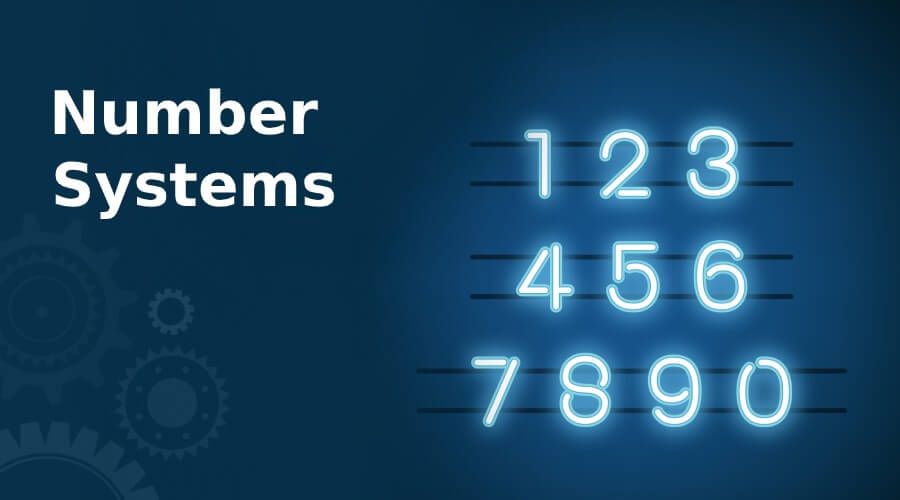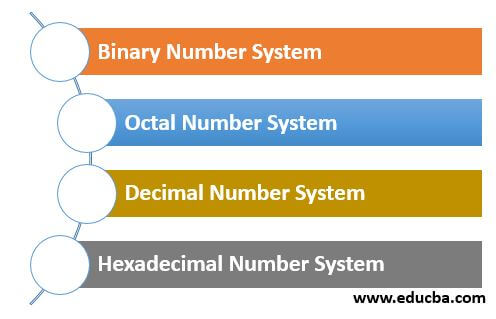Updated April 14, 2023

Introduction to Number Systems
We, humans, use words, numbers, and characters to communicate with each other. However, computers can not understand this language. Hence the data is converted to an electronic signal when we reach data. Each pulse is known as code, and ASCII translates the code to a numeric format. It creates a numerical value that digits for each digit, symbol, and character that a system understands. The numerical value of a digit in a number can be specified using The number, The position of the digit in the number, The base of the system. Therefore to understand computer language or communicate with the system, one needs to know the number systems.
Types of Number Systems
The Number Systems in computers are as given as follows:

1. Binary Number System
Binary system uses only two digits ‘0’ and ‘1’ hence base is 2. So it is also known as the base 2 number system.
In this system, there are two types of electronic pulses. If there is no electronic pulse then the digit is represented by ‘0’ and If there is an electronic pulse present then it’s 1′. Single binary digit is a bit. A sequence of four bits (1001) is a nibble and a sequence of eight bits(11001010) is called a byte. Binary represents a specific power of the base (2) of the number system. Example, 20. The last position in a binary number represents an x power of the base (2). Example, 2x where x represents the last position -1.
Example
Here we will see an example of how to calculate the Decimal Equivalent of a binary number
Binary Number: 110012
110012 can be written as 11001
Step 1: ((1 x 24) + (1 x 23) + (0 x 22) + (0 x 21) + (1 x 20)) 10
Step 2: (16 + 8 + 0 + 0 + 2) 10
Step 3: 2610
2. Octal Number System
Octal system uses eight digits 0, 1, 2, 3, 4, 5, 6, 7 hence base is 8. Each position in an octal number indicates a 0 power of the base (8). So it is also known as base 8 number system. Eg. 80. The last position in an octal number represents an x power of the base (8). Eg.8x where x represents the last position -1.
Example
Here we will see example of how to calculate Decimal Equivalent of Octal number
Octal Number: 120718
120718 can be written as 12071
Step 1: ((1 x 84) + (2 x 83) + (0 x 82) + (7 x 81) + (1 x 80)) 10
Step 2: (4096 + 1024 + 0 + 56 + 1) 10
Step 3: 5177
3. Decimal Number System
The decimal system uses eight digits 0, 1, 2, 3, 4, 5, 6, 7, 8,9 hence base is 10. In this number system, 9 is the highest digit value Whereas 0 is the lowest digit value. The position of each digit in a decimal number indicates a specific power of the base (10) of the system. We use the Decimal number system in our daily life. Decimal number system is able to indicate any numeric value.
Example
Here we will see an example of how to calculate Decimal Equivalent of a Decimal number
Decimal Number: 123710
123710 can be written as 1237
Step 1: (1 x 103)+ (2 x 102)+ (3 x 101)+ (7 x l00) 10
Step 2: (1 x 1000)+ (2 x 100)+ (3 x 10)+ (7 x 1) 10
Step 3: (1000 + 200 + 30 + 7) 10
Step 4: 1237
4. Hexadecimal Number System
Hexadecimal number system uses 10 digits and 6 letters, 0, 1, 2, 3, 4, 5, 6, 7, 8, 9, A, B, C, D, E, F. hence its base is 16. Each position in an octal number indicates a 0 power of the base (8). So it is also known as the base 16 number system as well as the alphanumeric number system Because it uses both numeric digits as well as alphabets.
Letters represent the numbers starting from 10. A = 10. B = 11, C = 12, D = 13, E = 14, F = 15. Each position in a hexadecimal number indicates a 0 power of the base (16). The last position in a hexadecimal number represents an x power of the base (16). Example 16x where x represents the last position -1.
Example
Here we will see example of how to calculate Decimal Equivalent of Hexadecimal number
Hexadecimal Number: 19FDA16
19FDE16 can be written as 19FDA
Step 1: ((1 x 164) + (9 x 163) + (F x 162) + (D x 161) + (A x 160)) 10
Step 2: ((1 x 164) + (9 x 163) + (15 x 162) + (13 x 161) + (10 x 160)) 10
Step 3: (65536+ 36864 + 3840 + 208 + 10) 10
Step 4: 106458
Conclusion
In this article, we have seen a Number system that is used to communicate with a computer along with decimal conversion. I hope you will find this article helpful.
Recommended Articles
This is a guide to Number Systems. Here we discuss a Brief Overview of Number Systems and its different types along with their examples. You can also go through our other suggested articles to learn more –

